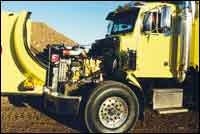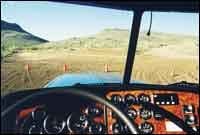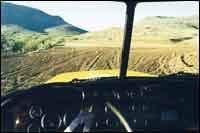Nose-to-Nose Contest on a Pair of Petes
Many truckers like bright colors because they grab attention and celebrate pride of ownership. Thus, the brilliant hues on these two Peterbilt 357s will certainly please a couple of owners and drivers. Motorists, whether they like the colors or not, are less likely to blunder into such trucks, so score one for safety.
They photograph well, too. But interesting specifications are really what caused me to focus on these two vehicles at the latest "King of the Hill" demonstration at Caterpillar's Tinaja Hills proving grounds south of Tucson, Ariz., a regular event co-sponsored by Peterbilt and Cat for customers and dealers. You can easily spot the differences in axle configurations, but not so obvious from the photos or even when viewed "live" are the two hood lines.
The yellow truck has a steeper hood slope, which is the latest enhancement to the Model 357. But if it's not obvious, is it worthwhile? You betcha. Get behind the wheel of both, as I did, and you find you really can see better over the lowered nose. This allows a driver to spot people and objects on a street or jobsite almost 5 feet closer than with the regular hood, according to Peterbilt measurements.
The altered Model 357 remains brutishly handsome because the hood slope is subtle. Steeper hoods on some other trucks are even easier to see over, but can look awkward. Let's face it, styling can affect how drivers treat their trucks, which has a bearing on maintenance expense as well as recruiting and retention issues. And good looks, along with reliability and toughness, are among the reasons most Peterbilts shine like gold at resale time.
On these trucks, hood length is the same and so is the bumper-to-back-of-cab dimension of 119 inches. The steeper slope is a no-cost option on the 357, and will become standard this Fall. The taller nose will disappear as cooling packages change for Cat's upcoming ACERT diesels.
As for axle configurations, you buy what your state's weight laws allow. Laws will favor forward-set or setback steer axles, on the blue and yellow trucks, respectively—while both laws and local custom influence choosing a steerable or non-steerable pusher axle —another variation in specs between these trucks. Both were built for states allowing heavy axle loads.
The blue truck's steerable pusher can carry 13,500 pounds in Maryland, said Mike Jones, Peterbilt's accounts manager for construction, who can rattle off many variations among states. The yellow truck's non-steerable pusher can take up to 20,000 pounds in Indiana, Kentucky and other central and southern states. A hefty tube and dual wheels and tires at each end give the non-steering axle the strength to take the higher weight. The poundage allowances assume the proper wheelbase, of course.
Steerable pusher axles are required in an increasing number of states, he said. One is Maryland, where authorities want the axles to stay down during turns and other on-road maneuvers, and that's why the blue truck has this lift-axle type. A practical advantage is that drivers needn't remember to raise their pushers while making turns.
Reverse-castering lift axles are now available. But as you probably know, the forward-steer-only type is protected by an interlock that raises the axle when the driver shifts into reverse.
Either type of axle automatically comes up when the parking brake is set. This is a fail-safe mechanism which prevents a lowered lift axle from jacking an empty truck's drive axles off the ground, when their parking brakes would be useless and the truck prone to roll away.
Some states allow non-steering axles to be raised in turns, and/or local authorities don't worry about increased pavement wear that results. These are also the states that allow higher weights on a pusher. Non-steering axles cost a little less. And drivers seldom forget to raise their axles anyway, so scuffing and lateral-force damage to tires, wheels and chassis parts is rare.
Both trucks have Heil integrated dump bodies, which you can order through your Peterbilt dealer. As you can see, their lengths differ slightly, and one has horizontal bracing while the other has slanted reinforcers.
Aside from all that, these trucks were almost twins in how they drove and handled. Both had powerful Cat C-12s, now in post-Oct. 1 Clean Power trim with combination muffler-catalytic converters to snare more nitrogen oxide from the exhaust stream. These are 10 inches in diameter, like before, but dual stacks are needed with engines over 350 horsepower. A single exhaust gets a 14-inch-diameter muffler/converter, but in most dump trucks must be hung horizontally from the frame. Still standard is the pleasing deep-throated exhaust note that the Cats produce.
Both engines had Jake Brakes that helped on downgrades, and worked through Fuller LL-type transmissions that were easy to shift. Steering was surprisingly nimble, in spite of wide-base "duplex" wheels and tires and dual power gear on their steer axles. These big items limit wheel cut, even with a setback axle, so turning circles seemed similar.
Peterbilt's stout aluminum cab gets special reinforcing for off-road running, and steel pieces are added if really severe service is anticipated. This cab goes back to the mid-1980s, and its exceptional utility will probably keep it around for many more years. It's not wide by today's standards, but a narrower cab has weight advantages and is more than adequate for just the driver, who constitutes the "crew" in most construction trucks.
The narrow cab also puts the right-side windows closer to the driver's eyes, making the windows effectively larger without bigger and heavier glass. This further cuts weight and enhances outward visibility. Slap on that sloping hood, paint it any eye-popping color, and you've got a truck that both sees and can be seen.






